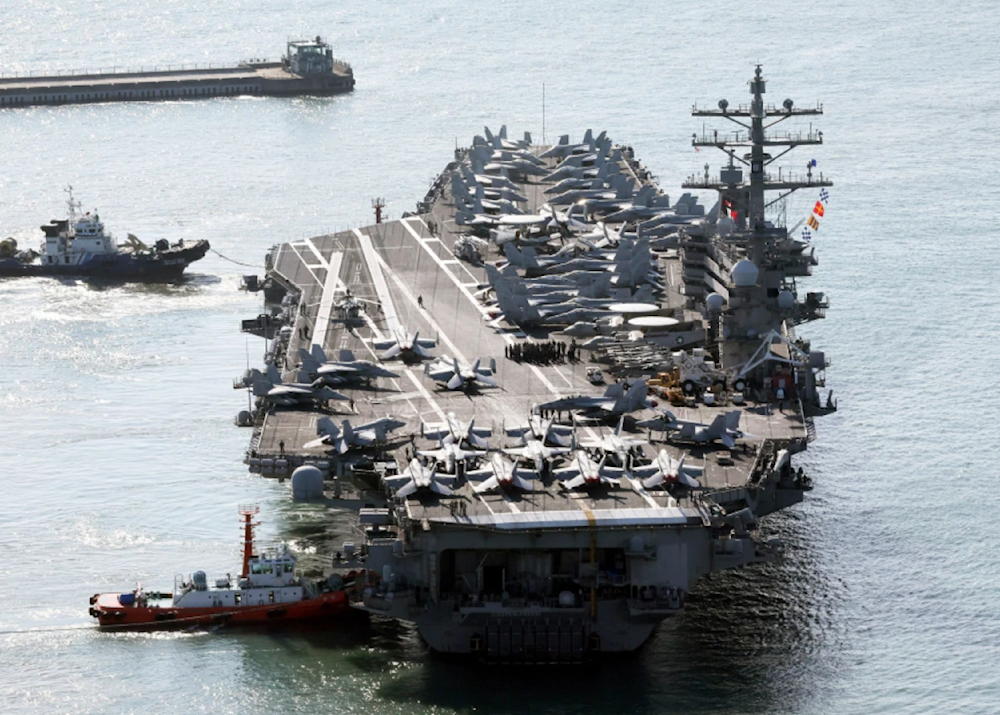What threats are the once-dominant US aircraft carriers facing?
Highlighting the increasing vulnerabilities of aircraft carriers in modern warfare, Brandon J. Weichert highlights the significant challenges the once-dominant aircraft carrier is facing.
-

The USS Ronald Reagan, a nuclear-powered aircraft carrier, is escorted as it arrives in Busan, South Korea, in October 2023. (AP)
US aircraft carriers have been a vital pillar of the US Navy's force for 80 years. However, their usefulness is now questioned owing to increased threats, notably from China, Russia, and the Yemeni Armed Forces (YAF), according to Brandon J. Weichert. The expensive cost and upkeep of aircraft carriers are also being scrutinized.
In an article on The National Interests' The Buzz blog, Weichert underlines how the main threats the carriers are facing are advancements in unmanned vehicles, "Carrier Killer" missiles, such as the DF-21D and DF-26B developed by some countries like China, hypersonic missiles, advanced surveillance and tracking, and nuclear threats.
The growth of automated warfare was seen in 2016 when a Chinese ship seized a US unmanned underwater drone in the South China Sea, revealing China's strong interest in US UUV technology. With China's sophisticated high-tech industry, competition for autonomous underwater drones is increasing, ushering in a new technical era in naval combat.
According to Weichert's article in The National Interest, underwater drones can be used to gather data on enemy fleets, conduct real-time meteorological inspections, and deliver explosives for targeted strikes.
The threat posed by unmanned underwater vehicles (UUVs) is expanding, particularly in areas such as the Red Sea, where the Yemeni Armed Forces (YAF) have deployed them.
UUV, UAV threats
Although naval experts say UUVs are "inherently harder to detect and counter" than surface vessels, UAVs and UUVs can work together to assault a ship from above and below, possibly overwhelming its defenses.
The US deployed two aircraft carriers to the Middle East after October 7, the new USS Gerald R. Ford to the Eastern Mediterranean and the older USS Dwight D. Eisenhower to the Gulf.
An Iranian military drone approached the Eisenhower, which was operating near Iranian territory, and flew within 1,500 yards of the carrier, prompting a public censure from the US Central Command (CENTCOM). While a single UAV may be controllable, a swarm poses a major threat, as the Navy accepts despite public denials.
Weichert believes that the biggest threat to an aircraft carrier is not its destruction, which is tough, but rather neutralizing its flight deck, which is critical for launching and retrieving jets.
In addition, China has created a sophisticated remote-sensing satellite equipped with cutting-edge artificial intelligence. In the summer of 2021, this technology displayed its capacity to follow American aircraft carriers as they traveled.
This satellite technology might improve the DF-26B missile's targeting accuracy, allowing it to successfully attack an aircraft carrier, either by crippling its flight deck or sinking it, posing a serious strategic vulnerability for the United States.
Hypersonic missiles, nuclear threats
Weichert argues that Russia is the global leader in hypersonic weapon development, with China closely following. The US lags in this technology. Hypersonic weapons, representing a major advancement in missile technology, pose a significant threat to US aircraft carriers.
Unlike conventional missiles, hypersonic weapons travel at extremely high speeds and along unpredictable paths, making it difficult to intercept them. This unpredictability and speed mean that hypersonic missiles could potentially cause catastrophic damage or sink aircraft carriers. Currently, there are no effective defenses against these weapons.
Finally, an enemy may decide to launch a nuclear attack on a carrier. While carriers are well-defended against most conventional kinds of assault, a nuclear attack on a carrier would be disastrous for both the ship and its crew.
Weichert concludes by noting that "the carrier’s days are coming to an end," emphasizing that the US should not "sacrifice these behemoths on the altar of its vanity."
Last month, the US deployed around 18 warships, including two aircraft carriers, in and around the Middle East, attempting to reportedly deter Iran and stop an inevitable retaliation for "Israel's" assassination of Hamas’ political bureau chief, martyr Ismail Haniyeh, Axios reported on August 29.
Some of the ships operating in the Red Sea and Gulf of Aden have been attempting to curb the operations of the Yemeni Armed Forces in support of Gaza for months, while more Navy and Air Force assets are being sent.
In addition to the two carrier strike groups currently operating in the Middle East, an Air Force F-22 Raptor squadron has already arrived, and the guided-missile submarine USS Georgia is close by.
Disclosing the position or destination of a submarine, such as the nuclear-powered USS Georgia, is an unusual and deliberate act, the news website pointed out.

 5 Min Read
5 Min Read








